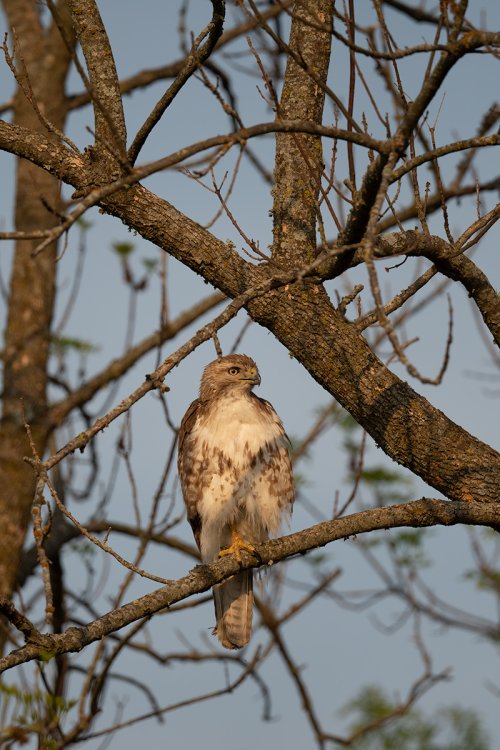I am going to do 2 version, One holding the Camera normal, and the other will be same subject but one of my first times holding the camera sideways for the tall framing.
I was driving along a park road and suddenly saw this Red-Tailed Hawk and stopped the car rolled down the wind and leaning over the car console snapped the images, I was almost too close for the 500mm lens, Then I thought to rotate it sideways (Something I rarely try). This bird was about 2-3 car WIDTHS away from me (Not Car Lengths).
The first image is just a straight save right from the camera card exported as a JPG in Lightroom NO EDITING AT ALL. The second one I ran through Topaz Labs Denoise and Sharpen AI and in Lightroom auto adjust for white balance, then slightly (I think) adjusted the colors to try to accent it closer to the sunset golden hour that I took the shot it in and make the sky a bit bluer. the 3rd is a crop of the second.
I had to export to a smaller size (5,000k), the forum would not let me post the 17,500k+ versions. I am not sure how that will affect the original quality or your abilities to critique them.
Camera: D500, Lens: 500mm f/5.6 PF, Exposure: 1/3200th @ f/11
1. How was the original untouched photo? How was my original framing before the crop?
2. How was the editing? Too little, too much etc.
3.. How is the crop? Again too little, too much?
I am still trying to learn my cameras settings and how to do bird photography and I suspect my Camera settings were also wrong, too high on ISO for one.





I was driving along a park road and suddenly saw this Red-Tailed Hawk and stopped the car rolled down the wind and leaning over the car console snapped the images, I was almost too close for the 500mm lens, Then I thought to rotate it sideways (Something I rarely try). This bird was about 2-3 car WIDTHS away from me (Not Car Lengths).
The first image is just a straight save right from the camera card exported as a JPG in Lightroom NO EDITING AT ALL. The second one I ran through Topaz Labs Denoise and Sharpen AI and in Lightroom auto adjust for white balance, then slightly (I think) adjusted the colors to try to accent it closer to the sunset golden hour that I took the shot it in and make the sky a bit bluer. the 3rd is a crop of the second.
I had to export to a smaller size (5,000k), the forum would not let me post the 17,500k+ versions. I am not sure how that will affect the original quality or your abilities to critique them.
Camera: D500, Lens: 500mm f/5.6 PF, Exposure: 1/3200th @ f/11
1. How was the original untouched photo? How was my original framing before the crop?
2. How was the editing? Too little, too much etc.
3.. How is the crop? Again too little, too much?
I am still trying to learn my cameras settings and how to do bird photography and I suspect my Camera settings were also wrong, too high on ISO for one.
You can only see EXIF info for this image if you are logged in.
You can only see EXIF info for this image if you are logged in.
You can only see EXIF info for this image if you are logged in.
You can only see EXIF info for this image if you are logged in.
You can only see EXIF info for this image if you are logged in.
Attachments
Last edited:



